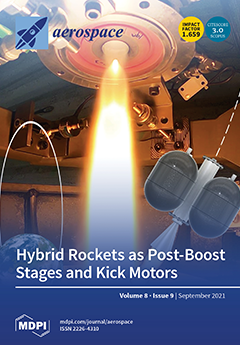Hybrid rockets are attractive as post-boost stages and kick motors due to their inherent safety and low cost, but it is not clear from previous research which oxidizer is most suitable for maximizing ΔV within a fixed envelope size, or what impact
O
[...] Read more.
Hybrid rockets are attractive as post-boost stages and kick motors due to their inherent safety and low cost, but it is not clear from previous research which oxidizer is most suitable for maximizing ΔV within a fixed envelope size, or what impact
O/
F shift and nozzle erosion will have on ΔV. A standard hybrid rocket design is proposed and used to clarify the impact of component masses on ΔV within three 1 m
3 envelopes of varying height-to-base ratios. Theoretical maximum ΔV are evaluated first, assuming constant
O/
F and no nozzle erosion. Of the four common liquid oxidizers: H
2O
2 85 wt%, N
2O, N
2O
4, and LOX, H
2O
2 85 wt% is shown to result in the highest ΔV, and N
2O is shown to result in the highest density ΔV, which is the ΔV normalized for motor density. When
O/
F shift is considered, the ΔV decreases by 9% for the N
2O motor and 12% for the H
2O
2 85 wt% motor. When nozzle erosion is also considered, the ΔV decreases by another 7% for the H
2O
2 85 wt% motor and 4% for the N
2O motor. Even with
O/
F shift and nozzle erosion, the H
2O
2 85 wt% motor can accelerate itself (916 kg) upwards of 4000 m/s, and the N
2O motor (456 kg) 3550 m/s.
Full article





